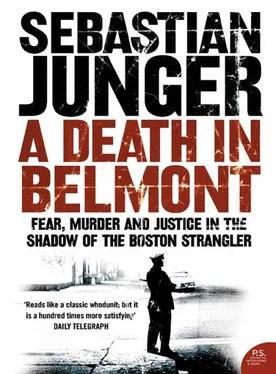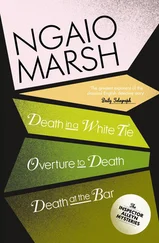My mother didn’t see Al again until the next day. He showed up with Blomerth and Wiggins because the job was almost done and they had to start packing their tools and cleaning up the site. Blomerth had brought a camera for the occasion, and he arranged us all inside the studio and took a photograph. I’m looking straight at Blomerth—no doubt because he said something to get my attention—and my mother, seated on a maplewood bench, is looking down at me, her firstborn child, rather than up at the camera. She is thirty-four years old, and her dark brown hair is pinned high on her head and she wears a paisley shirt with the sleeves neatly rolled up and she appears primarily interested in the baby on her lap. Behind my mother and off her right shoulder is old Mister Wiggins standing politely in a sweater-vest with his hands clasped behind his back and a claw hammer jammed headfirst into his front pocket. His shirt is buttoned right up to his chin, and he looks like he’s at least seventy-five years old. Standing next to Wiggins and directly behind my mother is Al.
Al and I are the only people looking directly at the camera, and whereas I have an infant’s expression of puzzled amazement, Al wears an odd smirk. His dark hair is greased up in a pompadour, and he is clean-shaven but unmistakably rough looking, and he has placed across his stomach one enormous, outspread hand. The hand is visible only because my mother is leaning forward to look at me. The hand is at the exact center of the photograph, as if it were the true subject around which the rest of us have been arranged.
IT WASN’T UNTIL Israel Goldberg started putting the food away in the kitchen that he realized something was wrong. His wife, Bessie, had asked him to pick up frozen vegetables and cheese on his way home from work, but when he pushed open the front door and called out her name, all he heard was the radio. That was odd; Bessie had hired a cleaning man to help get the house ready for a dinner party that night, and Israel had expected to find them both at work when he arrived home. Instead, the house was deserted and there wasn’t even a note. Bess! he shouted from the kitchen, but still no one answered, and that was when his puzzlement turned to fear. He dropped his overcoat on the floor and ran upstairs, calling his wife’s name as he went. He checked thir bedroom. He checked their closets. He checked the spare bedroom. He checked their daughter’s old bedroom: no one.
Outside, Israel could hear the shouts of children playing kickball on the street; a boy named Dougie Dreyer was single-handedly scoring run after run against an assemblage of neighborhood girls. John F. Kennedy was president, America was not yet at war, and Belmont, Massachusetts, where he and his wife had moved ten years earlier, was arguably the epitome of all that was safe and peaceful in the world. There were no bars or liquor stores in Belmont. There were no poor people in Belmont. There were no homeless people in Belmont. There were no dangerous parts of Belmont, or poor parts of Belmont, or even ugly parts of Belmont. There had never been a murder in Belmont. It was—until the moment Israel Goldberg went back downstairs and finally glanced into the living room—the ideal place to live.
The first thing he noticed was his wife’s feet, which protruded from behind the corner of the wall. Israel stepped into the living room to investigate. A standing lamp had been knocked over, and its pedestal was now propped on the arm of the divan. Between the lampshade and the knocked-over lamp lay the immobile body of his wife.
Bessie Goldberg was on her back with her skirt and apron pulled up and her legs exposed. One of her stockings had been wound around her neck, and her eyes were open, and there was a little bit of blood on her lip. The first thought that went through Israel Goldberg’s mind was that he’d never seen his wife wearing a scarf before. An instant later he realized that her head was at the wrong angle, that her face looked puffy and that she wasn’t breathing. According to the children on the street, Israel Goldberg was inside less than a couple of minutes before he screamed and ran back out and demanded to know if they had seen anyone leave the house. They hadn’t, though they would later remember a black man passing them on the sidewalk as they walked home from school. A black man was not a common sight in Belmont in 1963, and virtually every good citizen who had seen him walking down Pleasant Street that afternoon remembered him.
In hindsight—Belmont now forever marred by its first murder—some witnesses agreed that the black man might have looked like he was in a hurry. He had glanced back several times. He had walked fast, hands in his coat pockets, and had almost walked into some bushes as he passed Dougie Dreyer and two neighborhood girls on their way home from school. A sub-shop owner named Louis Pizzuto caught sight of him from behind his restaurant counter and was sufficiently curious to step around to the doorway to watch him pass. The black man had stopped in at the Pleasant Street Pharmacy across the street and then reemerged a few minutes later with a pack of cigarettes. The teenage boy who worked at the pharmacy said that he had bought a pack of Pall Malls for twenty-eight cents but had not seemed nervous. A middle-aged woman said that he hadn’t seemed nervous but that the skin of his face was “pocky.” Sometime later Louis Pizzuto walked into the pharmacy to make sure everything was okay. So what did the big darkie want?—or something much like that—he asked the boy behind the counter.
Not much, it seemed, except the cigarettes. The black man was tall and thin and wore brown checked pants and a black overcoat. Some remembered him wearing a dark hat and sunglasses, and some remembered that he had a moustache and sideburns. Soon it would be known that he crossed the street to the bus stop and boarded the first bus that came, which, unfortunately, was going in the wrong direction. Instead of getting off, he stayed on it to Park Circle, smoked a cigarette with the bus driver during the five-minute layover and then continued back toward Cambridge. He stepped off the bus in Harvard Square at nineteen minutes to four and walked past Out-of-Town News to the closest bar he could find. He would have been sitting at the bar counter ordering a ten-cent beer just as Israel Goldberg opened the door of his strangely quiet home. He would have been in a taxicab heading toward a friend’s apartment in Central Square when police cruisers began converging on Scott Road. And he would have been walking around Central Square looking for his girlfriend—who had left him several days earlier—when Leah Goldberg, Bessie and Israel’s twenty-four-year-old daughter, arrived at the murder scene and was led by a police officer to her stunned and grief-struck father.
Leah chose not to look at her mother’s body; the last time she’d seen her mother was at dinner the night before, and she wanted to keep it that way. She did cast around the house, though, and spotted on the kitchen counter a piece of paper that the police officers had missed. It was from the Massachusetts Employment Security Office on Huntington Avenue in Boston, and it had a name written on it. Shortly after that discovery the phone rang, and a woman named Mrs. Martin asked for Israel Goldberg. Mrs. Martin said she was calling from the Massachusetts Division of Employment Security and just wanted to know how the new cleaning man had worked out.
He murdered my wife, that’s how he worked out! Israel Goldberg screamed into the phone.
The name on the employment stub was Roy Smith. Smith was originally from Oxford, Mississippi, but his records at Employment Security had him living at 441 Blue Hill Avenue in Roxbury. That wasn’t true; he really lived with his girlfriend at 175 Northampton Street in Boston. The landlady, however, told the police that Smith’s girlfriend had moved out four or five days earlier. Two plainclothes officers stayed on Northampton Street while word went out to the Cambridge police station that Smith might be in the area looking for his girlfriend. At 11:13 p.m. the police issued a bulletin, accompanied by Roy Smith’s mug shots and fingerprint data from a previous arrest, announcing that he was wanted for murder in the town of Belmont. Bessie Goldberg was the ninth Boston-area woman to be raped and strangled in less than a year, and many of the victims had been elderly. If Roy Smith had indeed killed Bessie Goldberg—and by now the authorities knew that his criminal history included grand larceny, assault with a dangerous weapon, and public drunkenness—they had their first break in a series of murders that had virtually paralyzed the city of Boston.
Читать дальше












